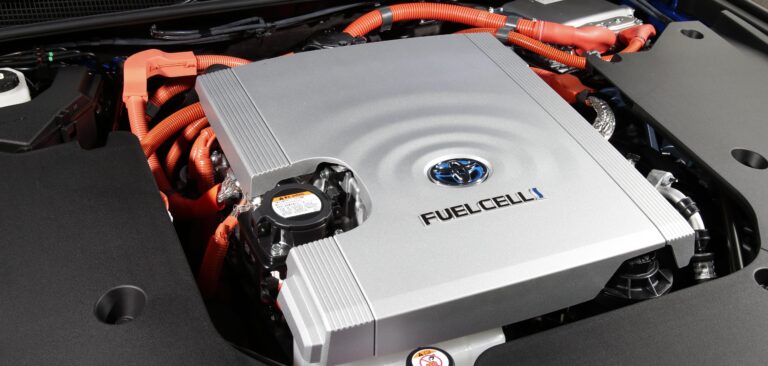Almost alone among major automotive manufacturers, Toyota is forging ahead with its development of FCEVs with the launch of a new version of its Mirai saloon. According to the company, priority has been given to improving the car’s driving range over the first-generation model.
Toyota notes that increased power and hydrogen capacity, coupled with improved efficiency and better aerodynamics, contribute to extending the driving range by 30%, to around 644km.
The Mirai will now be built on Toyota’s modular GA-L platform, which the company says enables a more efficient and well-balanced arrangement of the powertrain. Notably, the fuel cell stack has been moved from beneath the cabin to the front compartment.
The tanks are arranged in a ‘T’ configuration, the longest running longitudinally and centrally beneath the vehicle floor, with two smaller tanks set laterally beneath the rear seats and luggage compartment. Together they can hold 5.6kg of hydrogen, compared with 4.6kg in the current Mirai’s two tanks. Toyota states that the tanks now have a stronger, multilayer construction and are highly weight efficient – the hydrogen accounts for 6% of the combined weight of the fuel and tanks. Their position also contributes to the car’s lower center of gravity and avoids compromising load space. The high-voltage battery pack and motor are positioned above the rear axle.
Toyota says its latest fuel cell stack and fuel cell power converter (FCPC) have been developed specifically for use with the GA-L platform. The company notes that its designers have been able to bring all the elements together in the stack frame (including the water pumps, intercooler, air-conditioning and air compressors, and the hydrogen recirculation pump) with each part made smaller and lighter, and at the same time improving performance. The stack case itself has been made smaller by using friction stir welding, reducing the gap between the fuel cell and casing.
The fuel cell stack uses a solid polymer, as in the current Mirai, but it has been made smaller and has fewer cells (330 instead of 370). This gives a specific power density of 5.4kW/l (excluding end plates), and maximum power has risen from 114kW to 128kW.
Cold-weather performance has also been improved, with startup now possible at temperatures as low as -30°C.
Toyota claims that a focus on cutting weight while increasing output has netted a 50% weight reduction yet a 12% increase in power. This has been achieved via measures such as relocating the fuel cell manifold, reducing the size and weight of the cell, optimizing the shape of the gas channel separator and using new materials in the electrodes.
The fuel cell unit also incorporates a DC-DC converter (FDC) and modular high-voltage parts, while still achieving a 21% reduction in size compared with the current system. The weight of the converter has been cut by 2.9kg to 25.5kg. The unit also marks Toyota’s first use of silicon carbide semiconductor material in the intelligent power model (IPM) transistors. This enables an increase in output and lower power consumption while using fewer transistors, which in turn allows the FCPC to be made smaller.
The same size- and weight-saving approach has been applied to other parts of the FC stack. For example, the air intake is designed to reduce pressure loss and contains sound-absorbing material so that noise from the air inlets is unnoticeable in the cabin. Furthermore, the exhaust uses a resin pipe and is designed to allow for a large amount of air and water to be discharged; a larger-capacity silencer contributes to the quieter cabin. Toyota says the complete air system is almost 30% smaller than in the current Mirai and weighs more than a third (34.4%) less.
The new Mirai is also equipped with lithium-ion high-voltage battery in place of the current model’s nickel metal hydride unit. Although smaller in size, it is more energy dense, and contains 84 cells, with a rated voltage of 310.8V and a 6.5Ah capacity, compared with 244.8V and 4.0Ah in the old unit. The output has improved from 25.5kW x 10 seconds to 31.5kW x 10 seconds and the battery’s smaller dimensions have allowed it to be positioned behind the rear seats, avoiding intrusion in the load compartment. Cooling of the pack is achieved via two air ducts, one located on each side of the rear seating area.


